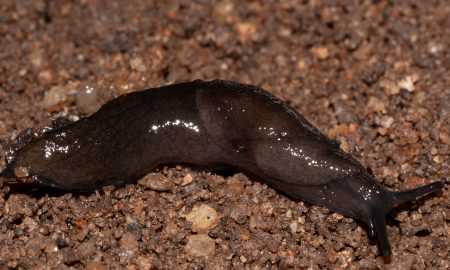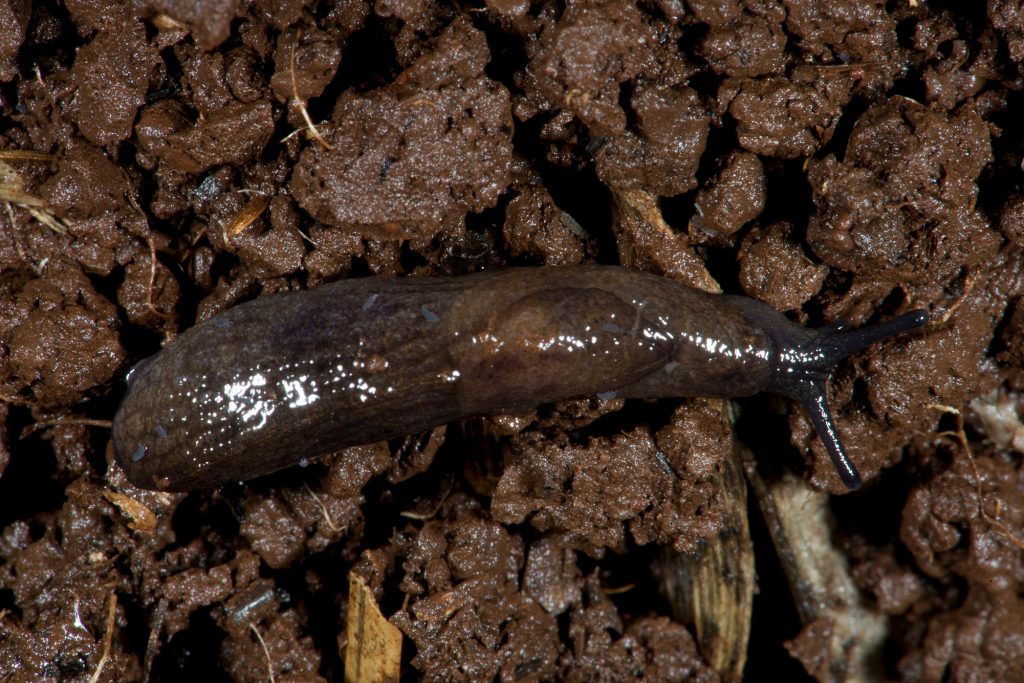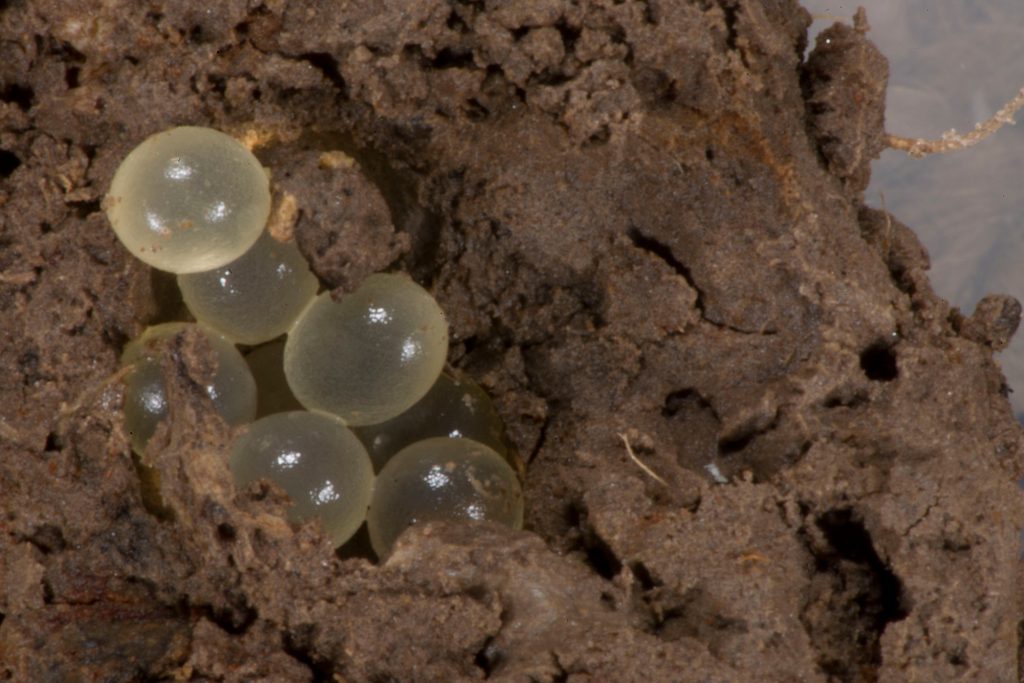Black keeled slug
Milax gagates

Photo by Andrew Weeks, Cesar Australia
Summary Top
Black keeled slugs are uniformly dark coloured with a prominent ridge or keel down the back. Being responsive to moisture they may breed and be active at any time of the year if suitable conditions prevail. Being a burrowing species they can attack germinating seeds underground. This species is a problem in southern and western cropping areas of Australia. No single control option will work; effective control requires the use of cultural and chemical options, while also encouraging the activities of beneficial species.
Control of slugs is a numbers game; a number of proactive strategies are required to successfully manage the pest.
Occurrence Top
Black keeled slugs are a problem in the higher rainfall climates (>450 mm) of southern Western Australia, South Australia, New South Wales and Victoria. Reduced tillage, stubble retention and irrigation increase the chance of occurrence in damaging numbers. Black keeled slugs prefer areas where moisture is retained, however they are better adapted to drier conditions compared with other slugs.
Description Top
Black keeled slugs grow to 60 mm in length and are usually dark brown-black in colour, with a prominent ridge (keel) running along the back. The body size, the colour and the keel are the distinguishing features of this slug species.



Lifecycle Top
Slugs are hermaphroditic (having both male and female reproductive organs) with the ability to delay mating and subsequent egg laying. Because this species actively burrows, they generally become surface active later in autumn than other slug species, after the breaking rains. Mating begins after sufficient rainfall, then egg clusters are laid into the top layer of moist soil once conditions are suitable. Eggs hatch 4-6 weeks later, dependent on temperature, and juvenile slugs feed throughout winter and spring, taking at least 8-9 months to become sexually mature. Their lifecycle can be delayed as individuals will remain dormant over the summer period in moist soil pockets and only become active when sufficient moisture is available. Thus, black keeled slugs can have either a bi-annual or annual lifecycle, depending on conditions. Because black keeled slugs burrow their behaviour enables them to resist greater temperature extremes and tolerate drier conditions than other species.
These slugs generally become active after the autumn break, but they are opportunistic and may breed and be active at any time of the year if suitable conditions prevail.
Similar to Top
The grey field slug, the striped field slug and the brown field slug.
Crops attacked Top
All crops and pastures, however the most susceptible crops are canola, especially young seedlings up to the six leaf stage and wheat seed/ pre-emerged seedlings in the drill rows.
Damage Top
Crops are vulnerable at establishment. Slug damage is usually patchy within a paddock. Irregular chewing marks on leaves and shredded leaf edges are typical damage symptoms. Seedlings can be eaten down to the ground resulting in seedling death. Black keeled slugs are a burrowing species and will also attack germinating seeds in the drill row. This damage is characterised by hollowing of the grain starting at the growing point. Feeding often leads to failure of the seedlings to emerge. Once germinated, cereal crops are more likely to grow out of slug damage. However, loss of plant numbers can result in decreased yields. Canola and lupins will not compensate for damage to cotyledons, as this leads to plant death, but once plants are established past six leaf stage they can compensate.
Damage in crops and control is complicated by the burrowing habits of black keeled slugs, therefore they can be a more serious pest than other slugs.
Monitor Top
Monitor all paddocks in high rainfall areas with, or that have received more than 500 mm rainfall, especially in crops of late sown canola. The most important time to monitor is the previous spring to understand where problems might occur, then after rain prior to seeding. Traditional methods like refuges traps (e.g. terracotta tiles) rely on slugs seeking refuge under them, however black keeled slugs often do not use these surface refuges. Estimating black keeled slug numbers using refuge traps can be misleading. Growers often assess slug feeding activity by spreading bran based bait from corner to corner of paddocks after rain and check the following morning for dead slugs.
Once the crop has been sown and germination has commenced, crops should be visually examined for damage and to ensure adequate rates of baits applied at sowing remain active to protect seedlings. Damp and mild conditions are optimal for slug activity; hence mornings after these conditions are the best time for monitoring.
Slug behaviour and populations are variable, hence monitoring is unreliable under dry conditions.
Economic thresholds Top
Despite being developed (Micic et al. 2007), thresholds are not reliable as populations cannot be accurately estimated. Cereal seedlings are more tolerant than canola.
Management options Top
Biological
Generalist predators thought to suppress populations include spiders, earwigs, free-living flatworms, and rove and carabid beetles. These play a valuable role but are unlikely to reduce populations below damage thresholds.
Cultural
Black keeled slugs actively burrow, hence burning is not an effective cultural control. Removal of summer volunteers, reducing the amount of stubble in paddocks and/or cultivation during autumn can all delay breeding, hence population increase. Seed bed consolidation (rolling) after sowing makes it harder for black keeled slugs to find seed, reduces surface clods used as moist refuges when slugs are surface active, and improves crop establishment when used in combination with cultivation. Sow high-risk paddocks to less susceptible crops, such as faba beans. Early sowing of vigorous canola cultivars will allowing faster establishment to six leaf stage, thus limit the time canola is vulnerable to damage when slugs are highly active.
Rolling will reduce slug access to germinating seed and enhance establishment.
Chemical
Baits are a crop protectant and must be applied immediately after sowing and rolling, prior to crop emergence. Drilling of baits will only protect seed but not seedlings, hence a follow up surface application is recommended. Thirty (30) pellets per m² are needed to ensure adequate chance of encounter. There are several molluscicidal baits registered against slugs in broad-acre crops with guidelines for effective usage being updated regularly by SARDI. Be aware that some baits are far more stable than others under adverse weather conditions including cold temperatures and significant rainfall. Iron III and metaldehyde formulated baits are effective in providing seedling protection against slugs and have limited effects on natural enemies. Remember to check affected areas after baiting and be aware that re-baiting may be required under high slug infestations or split emergence of populations due to different species co-occurring in the same field.
Baiting at sowing is the best chemical option to protect your crop.
Acknowledgements Top
This article was compiled by Michael Nash (SARDI) and Bill Kimber (SARDI).
References/Further Reading Top
Bailey PT. 2007. Pests of field crops and pastures: identification and control. CSIRO Publishing, Melbourne.
Bellati J, Mangano P, Umina P and Henry K. 2012. I SPY. Insects of Southern Australian Broadacre Farming Systems Identification Manual and Education Resource. Department of Primary Industries and Resources South Australia (PIRSA), the Department of Agriculture and Food Western Australia (DAFWA) and cesar Pty Ltd.
Bound S. 2005. Slug control in vegetable crops. Horticulture Australia Limited (HAL) VEGEnote.
Micic S, Henry K and Horne P. 2007. Identification and control of pest slugs and snails for broadacre crops in Western Australia. Bulletin 4713. Department of Agriculture and Food Western Australia.
Micic S, Hoffmann AA, Strickland G, Weeks AR, Bellati J, Henry K, Nash MA and Umina P. 2008. Pests of germinating grain crops in southern Australia: an overview of their biology and management options. Australian Journal of Experimental Agricultural 48, 1560-1573.
Nash MA, Thomson LJ and Hoffmann AA. 2007. Slug control in Australian canola: monitoring, mollusicidal baits and economic thresholds. Pest Management Science 63: 851-859.
| Date | Version | Author(s) | Reviewed by |
|---|---|---|---|
| March 2015 | 1.0 | Bill Kimber (SARDI) and Michael Nash (SARDI) | Garry McDonald (cesar) |
What are PestNotes?
PestNotes are information sheets developed through a collaboration between Cesar Australia and the South Australian Research and Development Institute (SARDI). Copyright: © All material published in PestNotes is copyright protected by Cesar Australia and SARDI and may not be reproduced in any form without written permission from both agencies.
Disclaimer
The material provided in PestNotes is based on the best available information at the time of publishing. No person should act on the basis of the contents of this publication without first obtaining independent, professional advice. PestNotes may identify products by proprietary or trade names to help readers identify particular products. We do not endorse or recommend the products of any manufacturer referred to. Other products may perform as well as or better than those specifically referred to. Cesar Australia and PIRSA will not be liable for any loss, damage, cost or expense incurred or arising by reason of any person using or relying on the information in this publication. Any research with unregistered pesticides or products referred to in PestNotes does not constitute a recommendation for that particular use.

